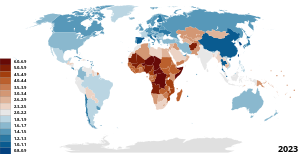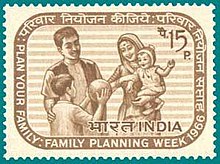

Family planning in India is based on efforts largely sponsored by the Indian government. From 1965 to 2009, contraceptive usage has more than tripled (from 13% of married women in 1970 to 48% in 2009) and the fertility rate has more than halved (from 5.7 in 1966 to 2.4 in 2012), but the national fertility rate in absolute numbers remains high, causing concern for long-term population growth. India adds up to 1,000,000 people to its population every 20 days.[1][2][3][4][5] Extensive family planning has become a priority in an effort to curb the projected population of two billion by the end of the twenty-first century.
In 2016, the total fertility rate of India was 2.30 births per woman[6] and 15.6 million abortions performed, with an abortion rate of 47.0 abortions per 1000 women aged between 15 and 49 years.[7] With high abortions rates follows a high number of unintended pregnancies, with a rate of 70.1 unintended pregnancies per 1000 women aged 15–49 years.[7] Overall, the abortions occurring in India make up for one third of pregnancies and out of all pregnancies occurring, almost half were not planned.[7] On the Demographic Transition Model, India falls in the third stage due to decreased birth rates and death rates.[8] In 2026, it is projected to be in stage four once the Total Fertility Rate reaches 2.1.[8]
- ^ Rabindra Nath Pati (2003). Socio-cultural dimensions of reproductive child health. APH Publishing. p. 51. ISBN 978-81-7648-510-4.
- ^ Marian Rengel (2000), Encyclopedia of birth control, Greenwood Publishing Group, ISBN 978-1-57356-255-3, archived from the original on 7 October 2015, retrieved 1 February 2016,
... In 1997, 36% of married women used modern contraceptives; in 1970, only 13% of married women had ...
- ^ Cite error: The named reference
who2009gdjwas invoked but never defined (see the help page). - ^ Cite error: The named reference
ramu2006was invoked but never defined (see the help page). - ^ Cite error: The named reference
bucen1997ahswas invoked but never defined (see the help page). - ^ "ESTIMATES OF FERTILITY INDICATORS" (PDF). data.worldbank.org. Archived (PDF) from the original on 19 August 2020. Retrieved 19 January 2020.
- ^ a b c Singh, Susheela; Shekhar, Chander; Acharya, Rajib; Moore, Ann M; Stillman, Melissa; Pradhan, Manas R; Frost, Jennifer J; Sahoo, Harihar; Alagarajan, Manoj (1 January 2018). "The incidence of abortion and unintended pregnancy in India, 2015". The Lancet Global Health. 6 (1): e111–e120. doi:10.1016/S2214-109X(17)30453-9. ISSN 2214-109X. PMC 5953198. PMID 29241602.
- ^ a b "Trends in Demographic Transition in India - General Knowledge Today". www.gktoday.in. Archived from the original on 12 April 2018. Retrieved 12 April 2018.